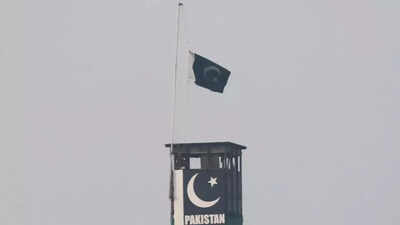
Why a loose missile can end up triggering nuclear war
Kenneth Mohanty / TNN / Mar 16, 2022, 11:46 IST
On March 9, an Indian missile ‘accidentally’ launched and landed in Pakistan. Although it didn’t cause serious damage, an incident like this involving hostile nuclear-armed neighbours is the stuff of military nightmares. The defence ministry has said it’s holding a high-level inquiry but Pakistan wants a joint probe
A little before 7pm on March 9, Pakistani military picked up a “high-speed flying object” originating inside Indian territory that “suddenly manoeuvred towards Pakistani territory”. The missile was not shot down but crashed on its own 120km inside Pakistani territory, destroying some civilian property.
On March 11, India said it was “a matter of relief that there has been no loss of life due to the accident”, which it termed “deeply regrettable” and the result of a “technical malfunction”.
India did not name the missile but analysts have concluded it was a BrahMos supersonic missile. Developed jointly with Russia, it is considered to be among the most advanced missiles of its class and also the fastest. More importantly, it has a range that covers most Pakistani cities.
Defence ministry sources said the missile was fired accidentally during a training and maintenance exercise near an IAF base in northern India where, incidentally, an audit by IAF’s Directorate of Air Staff Inspection was on.
Sources said the accidental launch occurred despite “multiple mechanical and electronic locks” built into BrahMos missiles that were “probably accidentally bypassed”.
Why is it a big deal?
A senior defence source said, “heads certainly need to roll” over the incident as it “could have led to a disastrous conflict” between two nuclear-armed neighbours. That’s because even though the missile was without a warhead, there would have been no way for Pakistani officials to know that. Its movement would have told them what kind of missile it was and could have led to an assumption that India had fired a nuclear weapon towards it. That could have triggered Pakistan into launching its own nukes towards India in playing out of the nuclear endgame known as “mutually assured destruction”.
Was it a ‘nuclear missile’?
The missile launched at Pakistan was of a non-nuclear configuration. However, it could well have been a nuclear-capable missile, in which case it might not have been unarmed. Since nuclear weapons are a deterrent, they normally need to be kept ready for deployment at the first sign of attack.
But who controls India’s nuclear weapons, and what happens in the case of an unintended launch? There is little clarity on this.
India has officially been a nuclear weapons state since 1998, and a Cabinet Committee on Security (CCS) note of 2003 laid down India’s “no first use” policy on nukes, implying that such weapons would only be used in retaliation against a nuclear attack, and that the response would have to be authorised by the political leadership through the Nuclear Command Authority (NCA).
The NCA’s political council, chaired by the PM, “is the sole body which can authorise the use of nuclear weapons”. Its decisions are based on inputs provided by the NCA’s executive council, which is led by the National Security Advisor. The executive council also executes the political council’s directives.
Can an airborne missile self destruct?
India and Pakistan had roughly 7 minutes to react till the missile completed its trajectory. Pakistan claimed to have tracked it but its air defence systems did not shoot it down while India failed to abort its flight. Experts say conventional missiles like the BrahMos do not have “self-destruct mechanisms” though strategic or nuclear missiles like Agni and Prithvi are said to have a kill switch. India and Pakistan signed an agreement in 2005 to provide advance notice to each other of any flight test “of any land or sea-launched, surface-to-surface ballistic missile”, but Pakistan said it was not informed of any such exercise on March 9. Indian authorities also did not issue any warning for air or marine traffic about any intended launch.
The world has had multiple close shaves with malfunctioning computer chips and mistaken launch assessments to assume that accidents involving nukes can be safely ruled out. Indeed, given the extremely low reaction times and high stakes involved, experts warn a nuclear war may be just a loose trigger away.
No comments:
Post a Comment